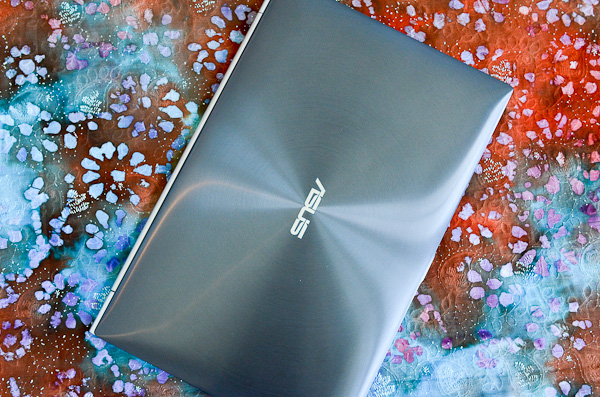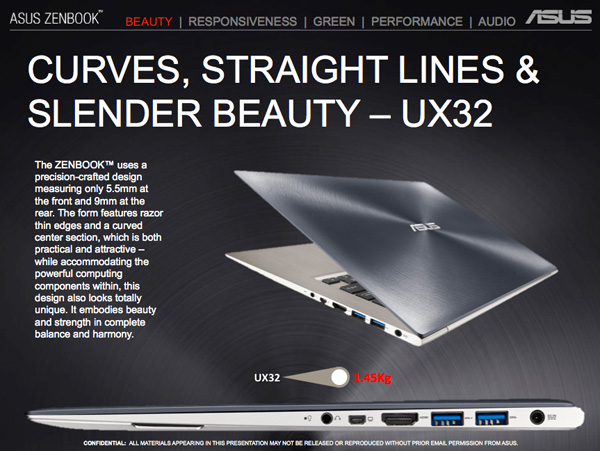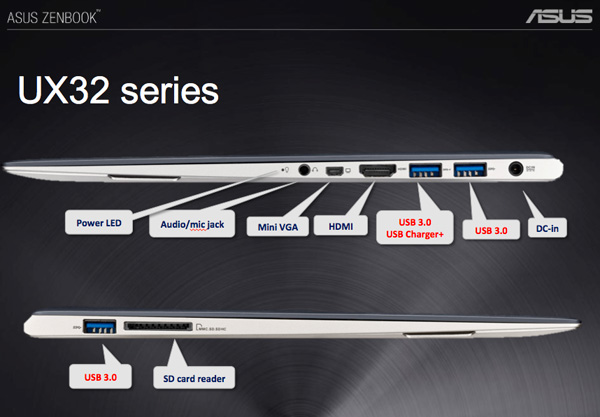ASUS Zenbook Prime (UX21A) Review: The First of the 2nd Gen Ultrabooks
by Anand Lal Shimpi on May 22, 2012 2:46 PM EST- Posted in
- Laptops
- CPUs
- Asus
- Ivy Bridge
- Zenbook
- Zenbook Prime
- Ultrabook
- Notebooks
The first round of Ultrabooks were mostly underwhelming. It shouldn't be a surprise, but many of the efforts were just half hearted at best. Of the companies who shipped the first Ultrabooks however, it was ASUS who came the closest to perfection with the Zenbook.
ASUS' Zenbook embodied the form factor, portability and overall concept of an Ultrabook. Where it failed to deliver was with its keyboard, display and, at least initially, with its trackpad. The first Zenbook was an amazing effort given the short period of time that it was conceived and developed in, but it was too rough around the edges.
Despite only being introduced 7 months ago, the Zenbook is old news. This is the Zenbook Prime:
The Zenbook Prime is ASUS' second generation Ultrabook, built around Ivy Bridge silicon. Unlike most silicon updates to notebooks however, the Zenbook Prime takes an almost Apple-like approach to renovating the tangibles rather than just relying on a faster chip to do the heavy lifting.
I don't know that I've ever seen a faster turn around on implementing reviewer and user feedback into a product. The Zenbook Prime fixes nearly every issue I had with the original Zenbook. From keyboard to display, it's all significantly better with the Zenbook Prime.
The circumstances around today's launch are a bit peculiar. Intel has an embargo in place on the as of yet unreleased Ivy Bridge CPUs, this applies to both notebooks and desktops. One such line of CPUs, the dual-core ultra-low-voltage Ivy Bridge parts that will find their way into many Ultrabooks, is covered by the aforementioned embargo. That embargo lifts at some point in the not too distant future, but ASUS wanted to have its review-ready hardware out the door and getting coverage before then. Why the urgency? It could have something to do with Apple's expected launch of updated MacBook Air and MacBook Pro systems. Rather than for Apple to get all the glory for being first, ASUS set some guidelines: we're allowed to talk about everything to do with the new Zenbook Primes, we just can't get into specifics on the CPU just yet. That's right, you won't read any model numbers, clock speeds or cache sizes here. Given what's already public about the ULV Ivy Bridge lineup I suspect this information isn't too hard to figure out if you're really motivated.

Zenbook Prime (left) vs. Zenbook (right)
The rest of the Zenbook Prime has nothing to do with Ivy Bridge. The form factor of the Zenbook Prime remains unchanged from its predecessor. Just like before we'll see two distinct models, an 11-inch (UX21) and 13-inch (UX31) in for review. With the lid closed, these two look identical to their Prime-less (composite numbered?) counterparts. ASUS sent the 11-inch Zenbook Prime in for review:
| ASUS Zenbook Prime Specs | |||||||||
| UX21A-DB5x | UX21A-DB7x | UX31A-DB51 | UX31A-DB52 | UX31A-DB71 | UX31A-DB72 | ||||
| CPU | ULV IVB | ULV IVB | ULV IVB | ULV IVB | ULV IVB | ULV IVB | |||
| GPU | HD 4000 | ||||||||
| Display | 11.6-inch 1920 x 1080 IPS | 13.3-inch 1920 x 1080 IPS | |||||||
| Memory | 4GB DDR3-1600 (on-board) | ||||||||
| Storage | 128GB U100 SSD | 128/256GB U100 SSD | 128GB U100 SSD | 256GB U100 SSD | |||||
| Wireless Connectivity | Intel Centrino N 6205, 802.11b/g/n 2.4/5GHz 2x2:2, Bluetooth 4.0 | ||||||||
| Battery | 35Wh | 50Wh | |||||||
| Camera | 720p front facing | ||||||||
| Audio | Bang and Olufsen ICEpower | ||||||||
| I/O | 2 x USB 3, 1x audio/mic, 1x microHDMI, 1x miniVGA | 2 x USB 3, 1 x audio/mic, 1 x microHDMI, 1 x miniVGA, 1 x SD Card reader | |||||||
| Dimensions | 299mm x 168.5mm x 3-9mm | 325mm x 223mm x 3-9mm | |||||||
| Weight | 1.1kg | 1.3kg | |||||||
| Price USD | TBD | TBD | $1099 | $1199 | $1499 | $1599 | |||
Pricing is still in the air as the Zenbook Prime won't be shipping until early June. I suspect much of how aggressive ASUS is on this front will depend on what Apple does in the coming weeks.
Introducing the UX32, Starting at $799
There's also a new member of the Zenbook Prime lineup, the 13-inch UX32. Featuring a thicker chassis, the UX32 will be offered as low as $799 with a 1366 x 768 TN panel, hard drive + SSD cache and as high as $1299 with a discrete NVIDIA GeForce GT 620M GPU:
| ASUS Zenbook Prime UX32 Specs | |||||||||
| UX32A-DB31 | UX32A-DB51 | UX32VD-DB71 | |||||||
| CPU | ULV IVB | ULV IVB | ULV IVB | ||||||
| GPU | HD 4000 | NVIDIA 620M + HD 4000 | |||||||
| Display | 13.3-inch 1366 x 768 TN | 13.3-inch 1920 x 1080 IPS | |||||||
| Memory | 2GB DDR3-1600 (on-board) + 2GB or 4GB SO-DIMM | ||||||||
| Storage | 7mm 320GB HDD + 24GB SSD (cache) | 7mm 500GB HDD + 24GB SSD (cache) | 7mm 500GB HDD + 24GB SSD (cache) | ||||||
| Wireless Connectivity | Intel Centrino N 6205, 802.11b/g/n 2.4/5GHz 2x2:2, Bluetooth 4.0 | ||||||||
| Battery | 48Wh | ||||||||
| Camera | 720p front facing | ||||||||
| Audio | Bang and Olufsen ICEpower | ||||||||
| I/O | 3 x USB 3, 1 x audio/mic, 1 x HDMI, 1 x miniVGA, 1 x SD card reader | ||||||||
| Dimensions | 325mm x 223mm x 5.5 - ~9mm | ||||||||
| Weight | 1.44kg | ||||||||
| Price USD | $799 | $999 | $1299 | ||||||
Depending on how well the SSD cache works, and how good the 1366 x 768 panel is, the $799 UX32A could be a very compelling system.













192 Comments
View All Comments
netmann - Saturday, June 9, 2012 - link
Anand did not open the bottom panel of UX21A this time around! But, I am curious to see if the SanDisk U100 is still the Gum Stick or the mSATA form factor. The SanDisk website does not show the Gum Stick type, only the mSATA and mini mSATA!If the SSD in UX21A is mSATA it can easily be upgraded with faster one such as Mushkin Atlas mSATA SSD. If U100 is Gum Stick perhaps it can be swapped with A-Data XM11 from previous Zenbook laptops or perhaps Runcore Rocket Air SSD. Your thoughts?
amosbatto - Sunday, June 10, 2012 - link
In GNU/Linux, you don't have the DPI scaling problem in menus, since its desktop environments let you set any font type and font size you want. Windows doesn't let you configure hardly anything.Anyone have any idea how well GNU/Linux supports this hardware? Since it is mostly stock Intel parts, I suspect that processor and graphics support is pretty good, but it would be nice to know if things like switchable TDP are possible. More importantly, does suspend and hibernate work correctly? How is the battery life in GNU/Linux.
And then there is the problem of touchpads, webcams, special buttons, etc. It would be really nice if review sites would list all the internal parts so we can google them and figure out what is supported in GNU/Linux, BSD, Haiku, etc. Not everybody likes to live in proprietary prisons.
amrs - Tuesday, July 31, 2012 - link
There are some issues with Linux but seem to be fixes too. Seems usable to me.See http://ubuntuforums.org/showthread.php?t=2005756 for discussion and https://help.ubuntu.com/community/AsusZenbookPrime for a wiki about the issues and fixes.
memin1857 - Friday, June 15, 2012 - link
I got the UX31A today and it has the 256GB ADATA XM11 Sandforce SSD! the package has the Sandforce Driven by LSI sticker. Also on the aliminium case. The model is UX31A-R4003V Turkish model with i7 cpu, FHD IPS Panel and 256GB SSD. I do not know if sandisk versiona exist. It was a nice surprise, I was worries about Sandisk U100 but it turns out to be Adata Sandforce :)netmann - Sunday, June 17, 2012 - link
Congratulation memin1857!I am also thinking of getting the UX31A or UX21A, however these are not available in US just yet! I currently own the UX31E. Did you get a chance to open the back panel to check the SSD in your UX31A? I am interested to know if your 256 GB ADATA XM11 is still a gum-stick format or a standard mSATA format. I am thinking of swapping the XM11 in my UX31E with the possible U100 in the A series laptops.
ilkhan - Saturday, June 23, 2012 - link
Swap the mini-VGA for a thunderbolt connector, remove the micro-HDMI and power LED for a full sized HDMI port.Fit a Gbit port on there somewhere or at least a bottom connected docking station with power/video/GBit/Sound.
Add a haswell quad CPU and a time appropriate midrange nVid GPU.
I'll get one next year.
Zodryn - Wednesday, July 4, 2012 - link
I recently received my ux31a from Amazon, and noticed a few interesting things:1) There are only two options in the configurable tdp section. 1.7GHz and 1.0GHz at 13W. There is no 16 or 17W option. This bothers me, as I was hoping for better gaming performance than my old ux21e, but at 13W, it was virtually the same. I could really use that extra bump. Anyone know why this is the case?
2) Adata SSD! This laptop is lightning fast. I attribute a good chunk of its speed to Sandforce.
3) When I have the brightness set to max, it is sometimes quite dim. It randomly and gradually brightens at times until it is very bright and pleasant to look at even in direct sunlight. It seems to have issues staying at a consistent brightness.
As a final note, my old ux21e (sandforce) boots in 16 seconds consistently. The ux31a (also sandforce), boots in 26 seconds consistently. This confuses me greatly.
yatahaze - Friday, August 3, 2012 - link
I've had a UX31A for a little over a month now, and my drive has gone horribly corrupt simply after waking it from sleep. Many many many errors reported by disk utilities.veteran_n00b - Thursday, August 23, 2012 - link
This just happened to me this morning. Tried to wake from sleep but the system was unresponsive. Forced shutdown and then it would not boot. I was able to get it going again with boot repair. Then I ran chkdsk the system file checker and found that there were a lot of corrupted files!Oh yeah, this is my 2nd laptop which I am in the process of returning because the webcam stopped working. My first one stopped charging one day so I had to return that.
I really want to like this laptop but wow, such quality issues!
ijozic - Tuesday, August 21, 2012 - link
I guess the review needs some update regarding the Ivy Bridge CPUs and the battery life in the low power mode, etc.